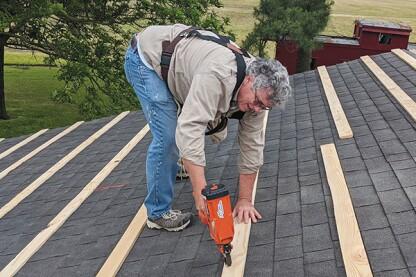Replacing an old, worn-out roof is a significant undertaking for any homeowner. However, there’s an alternative that not only saves you time and money but also provides a durable and eco-friendly solution: installing a metal roof over old shingles. In this article, we’ll explore the benefits, considerations, and steps involved in this roofing upgrade.

Why Choose a Metal Roof Over Old Shingles?
Cost Savings:
One of the primary reasons homeowners opt for a metal roof over old shingles is cost savings. Removing the existing shingles can be labor-intensive and costly. By installing a metal roof directly over the old shingles, you eliminate the need for tear-off, disposal, and associated labor expenses.
Time-Efficient:
Roof replacement projects can disrupt your daily life for several days. Installing a metal roof over old shingles is a quicker process, reducing the time your home is exposed to the elements.
Sustainability:
Metal roofs are known for their longevity and recyclability. By choosing this option, you reduce the amount of roofing material sent to landfills and contribute to a more sustainable roofing solution.
Considerations Before Installing
Structural Integrity:
Before proceeding, it’s essential to assess the structural integrity of your existing roof. Metal roofing is heavier than shingles, so your roof must be able to support the added weight. Consulting a structural engineer or roofing professional is advisable.
Quality of Old Shingles:
Examine the condition of the old shingles. If they are severely damaged, warped, or rotted, it’s best to remove them before installing the metal roof. Installing over compromised shingles can result in an uneven surface and reduce the new roof’s longevity.
Local Building Codes:
Check with your local building department to ensure that installing this roof complies with local codes and regulations. Some areas may have specific requirements for this type of installation.
Steps for Installing a Metal Roof Over Old Shingles
1. Roof Inspection:
Begin by thoroughly inspecting the existing roof for any issues. Repair any damaged or rotted areas and ensure the roof deck is in good condition.
2. Install Underlayment:
Cover the old shingles with a high-quality roofing underlayment. This acts as a moisture barrier and provides a smooth surface for the metal roofing panels.
3. Flashing Installation:
Proper flashing is crucial to prevent water infiltration. Install flashing around roof edges, valleys, and any roof penetrations.
4. Metal Roof Installation:
Secure the metal roofing panels following the manufacturer’s guidelines. Ensure proper alignment, fastener placement, and panel overlap for optimal weather resistance.
5. Trim and Finish:
Complete the installation with trim pieces, ridge caps, and any necessary accessories to ensure a watertight seal.
Benefits of a Metal Roof Over Old Shingles
- Cost-Effective: Save on tear-off and disposal costs associated with shingle removal.
- Durability: Metal roofs have a long lifespan and can outlast traditional shingles.
- Energy Efficiency: Reflective metal roofs can help lower cooling costs by reducing heat absorption.
- Environmentally Friendly: Contribute to sustainability by reducing waste and choosing recyclable materials.
Conclusion
Installing a metal roof over old shingles offers homeowners a cost-effective, time-efficient, and eco-friendly roofing solution. However, it’s essential to assess the existing roof’s condition, comply with local regulations, and follow proper installation procedures to ensure a successful and long-lasting upgrade. With the right considerations and professional guidance, you can enjoy the benefits of a durable metal roof that enhances both the aesthetics and functionality of your home.



Leave a Reply